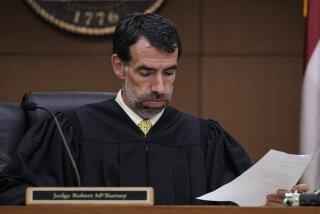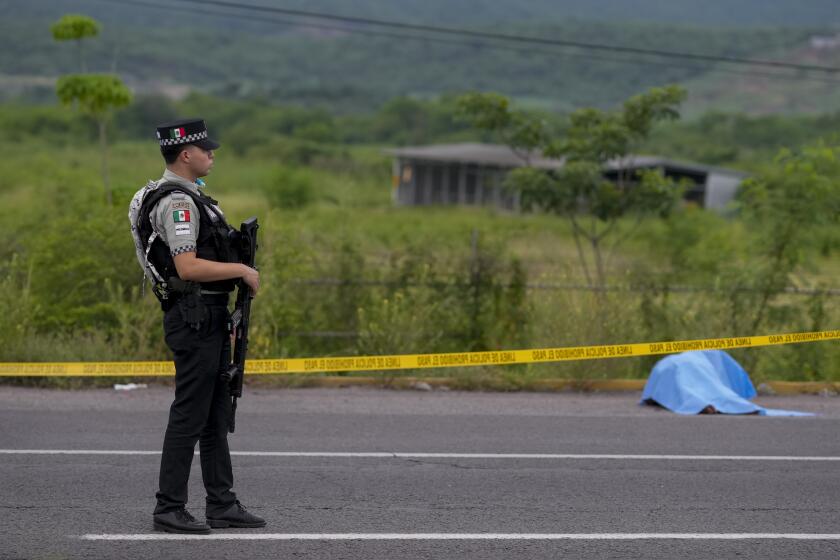Maryland Residents Staging Road Show to Slow Drivers
The sculpture is as close to an official traffic stopper as the law allows: A stick figure with an upraised, white-gloved hand, it is one of 19 artworks that Hyattstown residents have placed along a road in hopes of slowing the cars speeding past their front doors.
“If you see one, then all of a sudden, you start looking and, hopefully, your initial reaction is to slow down,” said Linda Tetens, an artist who helped organize the project.
The Road Show, as residents call it, is among the many approaches that people nationwide have devised for dealing with traffic problems that authorities won’t or can’t solve.
Others involve brightly colored flags, “pace cars,” homemade speed bumps, even a steel gate.
Tiny Hyattstown, about 25 miles northwest of Washington, isn’t even a wide spot in the road. That is one of the problems its 65 residents face in trying to slow drivers who ignore the 30 mph limit on Route 355, a state highway popular with commuters avoiding congested Interstate 270.
Some of the community’s 200-year-old houses are right beside the road, leaving little margin for parking -- which tends to slow passing cars -- or other “traffic-calming” features such as roundabouts and lane closings.
Tetens, who created some of the sculptures, said she and a neighbor once borrowed a police radar gun and found the average speed was at least 45 mph.
In the three years that Tetens has lived in Hyattstown, one neighbor’s car was hit by a motorcycle and another was rear-ended while slowing to make a turn.
In another accident, a driver who had stopped so that Tetens could pull out of her driveway was struck from behind.
The sculptures along the one-third-mile stretch include an enormous set of wind chimes hanging from a sturdy maple branch and six brightly colored pinwheels.
The display began in July and has been changed periodically.
“It’s been fun, artwise, and it’s been fun to see that it worked,” Tetens said.
Whether it really does work is unclear.
Bobby Donovan, another organizer of the project, said there have been at least three accidents along the strip in the past month.
He said community leaders are seeking help from state officials in installing sidewalks and establishing other visual cues that this is a residential area.
Hyattstown does not have its own police force. State police have helped nab tractor-trailers that illegally take the road to avoid a truck scale on I-270, but Montgomery County police say Hyattstown is just one small problem competing for officers’ attention.
Some residents of Madison, Wis., tried numerous tactics to make drivers yield to pedestrians after authorities refused to place additional stoplights along a commercial block of Monroe Street.
“We have done yard signs, Burma Shave signs, we have done speed boards, we have marked down who didn’t slow down and the police sent them warning letters. Most of these things had some effect, but mostly it was temporary,” said Ann Clark of the Dudgeon-Monroe Neighborhood Assn.
They found greater success with pedestrian flags, a strategy also in use elsewhere, including Salt Lake City.
Before stepping into the intersection, pedestrians can grab a tall, bright orange flag from a curbside canister. They wave it while crossing the street, then deposit it in a container on the other side.
“It’s been wonderfully effective,” Clark said.
She said no pedestrians have been struck by cars on the block since the project began in May, compared with two such accidents the previous 18 months.
Home-grown strategies in other communities have included:
* Pace cars in Mesa, Ariz., where residents who pledge to obey the speed limit can display “Official Neighborhood Pace Car” stickers on their vehicles to remind others to slow down.
* Speed bumps in Rodgers Forge, Md., where Andrew McBee used them to slow traffic in an alley behind his house for three years until he was ordered to remove them last summer. He molded each of the speed bumps out of six to eight bags of asphalt from Home Depot.
* An iron gate across a road that residents of Mukilteo, Wash., installed with city approval two years ago to prevent cars from speeding through their neighborhood at 60 mph. The gate was later removed by court order.
Stephanie Faul, a spokeswoman for the Washington-based AAA Foundation for Traffic Safety, said people who are tempted to take matters into their own hands should look into traffic-calming solutions such as cobblestone paving, lane obstructions and gentle, S-shaped curves.
“When people think of traffic-calming, they usually think of speed humps, and people hate speed humps,” she said. “There are things you can do, however.”
More to Read
Sign up for Essential California
The most important California stories and recommendations in your inbox every morning.
You may occasionally receive promotional content from the Los Angeles Times.










